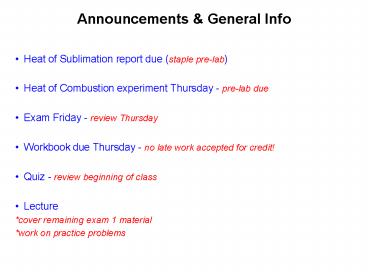Announcements - PowerPoint PPT Presentation
1 / 20
Title:
Announcements
Description:
Announcements & General Info. Heat of Sublimation report due ... (d) 1mol of KBr(s) or 1mol of KBr(aq) (e) Seawater in midwinter at 20C or in midsummer at 230C ... – PowerPoint PPT presentation
Number of Views:32
Avg rating:3.0/5.0
Title: Announcements
1
Announcements General Info
- Heat of Sublimation report due (staple pre-lab)
- Heat of Combustion experiment Thursday -
pre-lab due - Exam Friday - review Thursday
- Workbook due Thursday - no late work accepted
for credit! - Quiz - review beginning of class
- Lecture
- cover remaining exam 1 material
- work on practice problems
2
Entropy and the Second Law of Thermodynamics(Chap
ter 20)
- The First Law of Thermodynamics DEuniverse 0
- Does not predict ________of change, only that
______ is conserved. - Most reactions are ________________________ but
not all. - DH alone does not tell us ________________________
_. Why do some reactions go uphill in energy? - Systems have a natural tendency to become more
disordered
3
Spontaneous expansion of a gas
Figure 20.2
stopcock closed
1 atm
evacuated
4
Entropy
- The entropy (S) of a substance is a measure of
its disorder. - S k ln W
- k Boltzmanns constant, 1.38 x 1023 J/K
- W of possible states (ways of arranging the
components of a system)
- A system with many equivalent ways to arrange its
components (larger W) has more disorder and high
entropy.
5
Predicting Direction of Entropy Change
- In general
- Increasing temperature
- S increases as phase changes s ? l ? g
- Dissolution S increases for solids and liquids
on dissolving, but decreases when
____________________. - For similar substances, increase in mass and
larger or more complicated molecules will have
____________entropy.
6
Figure 20.6
The entropy change accompanying the dissolution
of a salt
pure solid
pure liquid
7
Sample Problem 20.1
Predicting Relative Entropy Values
(a) 1mol of SO2(g) or 1mol of SO3(g)
(b) 1mol of CO2(s) or 1mol of CO2(g)
(c) 3mol of oxygen gas (O2) or 2mol of ozone gas
(O3)
(d) 1mol of KBr(s) or 1mol of KBr(aq)
(e) Seawater in midwinter at 20C or in midsummer
at 230C
(f) 1mol of CF4(g) or 1mol of CCl4(g)
SOLUTION
8
The 2nd and 3rd Laws of Thermodynamics
- The Second Law of Thermodynamics states that the
entropy of the universe is always increasing - DSuniverse DSsystem DSsurroundings gt 0
- The Third Law of Thermodynamics The entropy of a
substance approaches zero as temperature
approaches absolute zero (0 K)
9
Standard Molar Entropies and DSrxn
- Standard molar entropies, S0, have been
tabulated for many substances in their standard
states. - These experimentally determined values allow
DS0rxn to be calculated - DS0rxn S (S0products) S (S0reactants)
- Prediction of the sign of ?Srxn
- Since gases have such high entropy, ?S will
usually be positive in the direction of the
reaction that produces the most moles of gas.
10
Sample Problem 20.2
Calculating the Standard Entropy of Reaction,
DS0rxn
11
Entropy Change in the Surroundings
DSuniverse DSsystem DSsurroundings gt 0 (2nd
Law)
This thermo law dictates that decreases in the
entropy of the system can occur only if increases
in the entropy of the surroundings outweigh them!!
- For an exothermic reaction qsyslt0 qsurrgto
- For an endothermic reaction qsysgt0 qsurrlto
- The entropy of the surroundings changes due to
heat transfer to or from the system, and depends
on temperature.
12
DG Determines Reaction Spontaneity
- Reminder For a reaction to be spontaneous,
DSuniverse DSsystem DSsurroundings gt 0.
- Multiplying by T TDSuniv DHsys TDSsys
- The expression on the left is called the Gibbs
Free Energy, DG. - For a system DG DH TDS
- If DG lt 0, process is
- If DG gt 0, process is
- Note, spontaneity is a thermodynamic property
only it does not tell us anything about the rate
of reaction (kinetics).
13
Calculating DG0rxn
- Either
- Calculate DG0 from DH0 and DS0
- DG0rxn DH0rxn TDS0rxn
- or
- Look up DGf0 defined in same manner as DHf0.
14
Sample Problem 20.4
Calculating DG0 from Enthalpy and Entropy Values
Use DH0f and S0 values to calculate DG0sys
(DG0rxn) at 250C for this reaction.
SOLUTION
DH0rxn S mDH0products S nDH0reactants
15
Sample Problem 20.4
Calculating DG0 from Enthalpy and Entropy Values
continued
DS0rxn S mDS0products S nDS0reactants
DG0rxn DH0rxn T DS0rxn
16
Sample Problem 20.5
Calculating DG0rxn from DG0f Values
PROBLEM
Use DG0f values to calculate DGrxn for the
reaction in Sample Problem 20.4
17
Effect of Temperature on Reaction Spontaneity
- DG0rxn DH0rxn TDS0rxn
- To determine whether a process is spontaneous,
both - If DH0 is negative and DS0 is positive, reaction
is spontaneous at all temperatures if DH0 is
positive and DS0 is negative, reaction cannot be
spontaneous. - If DH0 and DS0 have the same sign
- Higher T makes TDS term more important, so
reactions with positive DS will be favored at
higher temperatures - Reactions with ?H, DS lt 0 are spontaneous at
lower T
18
Crossover Temperature
- DG0rxn DH0rxn TDS0rxn
- The crossover temperature is the temperature at
which the direction of spontaneity changes, i.e.
DG0 0. - DG0 DH0 TDS0 0
- DH0 TDS0
- T DH0 / DS0
19
Example
- H2O (l) ? H2O (g)
- What is crossover temperature for this
transformation given the following data (from
Appendix B)
20
- STOP!































